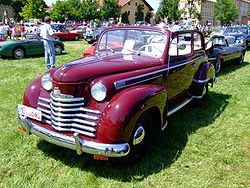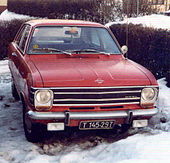- Opel Olympia
-
Opel Olympia 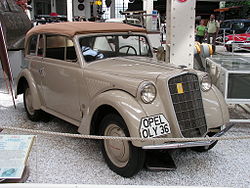
1936 Opel OlympiaManufacturer Opel Production 1935–70 Predecessor Opel 1.3 litre Successor Opel Rekord / Opel Ascona The Opel Olympia is a small family car produced by the German automaker Opel from 1935 to 1940, from 1947 to 1953 and again from 1967 to 1970.
The 1935 Olympia was Germany's first mass-produced car with an all-steel unitized body (monocoque).[1] This revolutionary technology reduced the weight of the car by 180 kilograms (400 lb.) compared to its predecessor.[2] Production of the unibody design required new production methods and materials. Spot welding, advanced types of steel, and a new production line layout were among the many advances introduced by the Olympia.[3]
The car was first presented in February at the 1935 Berlin Motor Show: production got under way later during that year. The Olympia was named in anticipation of the 1936 Berlin Olympic Games. Before World War II it was made in two versions. From 1935 to 1937 the Olympia had a 1.3 litre engine. For the OL38 version made from 1937 to 1940 this was replaced by a 1.5 litre overhead valve unit.
Between 1935 and the 1940 over 168,000 units were built.
The name Olympia was revived in 1967 for a luxury version of the Opel Kadett B.
Contents
Opel Olympia (1935–37)
Opel Olympia 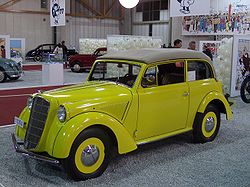
Production 1935–37
81,661 producedBody style 2-door saloon
2-door cabrioletEngine 1.3 L Straight-4 side valve Transmission 3 or 4 speed manual Wheelbase 2.37 m (93.3 in) Length 3.93 m (154.7 in) Width 1.43 m (56.3 in) At 2500 Reichsmark it offered a true four-seater with 1.3 litre, 4 cylinder, side valve, 24 hp (18 kW) engine capable of 95 km/h (60 mph). Drive was to the rear wheels through a three speed gearbox but a four speed unit became available in 1937. The car had independent front suspension with a live axle at the rear and semi-elliptic leaf springs.
The car was made available in two versions, as a two door saloon and as a two-door soft-top convertible:
- LZ 2-door 4-light saloon, costing 2500 Reichsmark
- CL 2-door 4-light cabriolet
Opel Olympia OL38 (1937–40) (1947–49)
Opel Olympia OL38 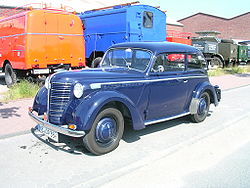
Production 1937–40
1947–49Body style 2-door saloon
4-door saloon
2-door cabrioletEngine 1.5 L Straight-4 ohv Wheelbase 2.43 m (95.7 in) Length 4.02 m (158.3 in) Width 1.50 m (59.1 in) A new engine was introduced in 1937 with a capacity of 1488 cc and overhead valves. It produced 37 hp (27 kW) and the top speed of the car was 112 km/h (70 mph). The car's body received a facelift.
It was available in the same versions as its predecessor with the addition of the 6-light LV:
- LZ 2-door 4-light saloon, 2675 Reichsmark
- LV 4-door 6-light saloon, 2950 Reichsmark
- CL 2-door 4-light cabriolet, 2750 Reichsmark
Due to World War II, production came to a halt in late 1940. During the war, the Opel plant in Rüsselsheim was severely damaged by allied bomb attacks. After reconstruction, production of the Olympia restarted in late 1947. The OL 38 was unchanged to the pre-war car but only the two door sedan was produced. Until the end of 1949, 25.952 of them were made.
Opel Olympia 1950 (1950–53)
Opel Olympia 1950 Production 1950–53 Body style 2-door saloon
2-door convertible
2-door estateEngine 1,5 L straight 4 OHV In January 1950, the Olympia got a modernized body. But the car was still based on the pre-war Olympia. The following bodies were offered:
- 2-door saloon, 6400 Deutsche Mark
- 2-door convertible, 6600 Deutsche Mark
- 2-door estate, 7350 Deutsche Mark
In three years of production, about 160.000 cars were made.
First successors: Opel Olympia Rekord (1953–57), later Opel Rekord (1957–86)
In March 1953, the 18 year old design of the Olympia was finally replaced by a completely new car. It was called Opel Olympia Rekord and it had a modern pontoon body. For this car and its successors, see Opel Rekord.
Name revival: Opel Olympia A (1967–70)
The Olympia name was revived in 1967. This time it was only a luxury version of the contemporary Opel Kadett B. Engines were a 1100 cc unit with 60 hp (44 kW) taken from the Kadett and two larger units, a 1700 cc with 75 hp (55 KW) and a 1900 cc with 90 hp (66 kW) which were normally used in the Opel Rekord.
Body styles were:
- 2-door saloon
- 4-door saloon
- 2-door coupé
The Olympia A was not highly successful, and was replaced in 1970 by the all new Opel Ascona.
Notes
- ^ GM Media Online, http://archives.media.gm.com/intl/opel/en/company/c_history/1930/index.html
- ^ Bartels, E.; Manthey, R. (2004). Opel Jahrbuch 2005, Brilon: Podszun (ISBN 3-86133-366-X), 37
- ^ Bartels, E.; Manthey, R. (2004). Opel Jahrbuch 2005, Brilon: Podszun (ISBN 3-86133-366-X), 35 ff.
References
External links
Opel Current Opel
passenger carsCurrent Opel
commercial vehiclesHistoric and
discontinued modelsAdmiral • Arena • Ascona • Bedford Blitz • Blitz • Calibra • Campo • Chevette • Commodore • Diplomat • 5/12 PS "Puppchen" • 4/8 PS "Doktorwagen" • Frontera • GT • Kadett • Kapitän • Laubfrosch • Manta • Monterey • Monza • Olympia • Omega • Patentmotorwagen „System Lutzmann“ • P4 • RAK • RAK1 • RAK2 • Regent • Rekord • Senator • Signum • Sintra • Speedster • Super 6 • Tigra • 10/30 (10/35) PS • 12,3-Liter-Rennwagen • VectraMotor racing cars Concept cars Divisions and
subsidiariesOpel Eisenach GmbH • Opel Motoren Kaiserslautern GmbH • Opel Powertrain GmbH • Opel Performance Center GmbH • Opel Special Vehicles GmbHOther Founder: Adam Opel • Opel InternationalOpel road car timeline, 1947–1970s next » Type 1940s 1950s 1960s 1970s 7 8 9 0 1 2 3 4 5 6 7 8 9 0 1 2 3 4 5 6 7 8 9 0 1 2 3 4 5 6 7 8 9 Small family car Kadett A Kadett B Kadett C Olympia Olympia Rekord Olympia A Large family car Rekord PI Rekord PII Ascona A Ascona B Executive car Rekord A Rekord B Rekord C Rekord D Rekord E Kapitän Kapitän Kapitän PI / PII Commodore A Commodore B Commodore C Luxury car Kapitän A / Admiral A / Diplomat A Kapitän B / Admiral B / Diplomat B Senator / Monza Coupé / Roadster GT Manta A Manta B Categories:- Opel vehicles
- Compact cars
- Vehicles introduced in 1935
- 1930s automobiles
- 1940s automobiles
- 1950s automobiles
- 1960s automobiles
Wikimedia Foundation. 2010.

